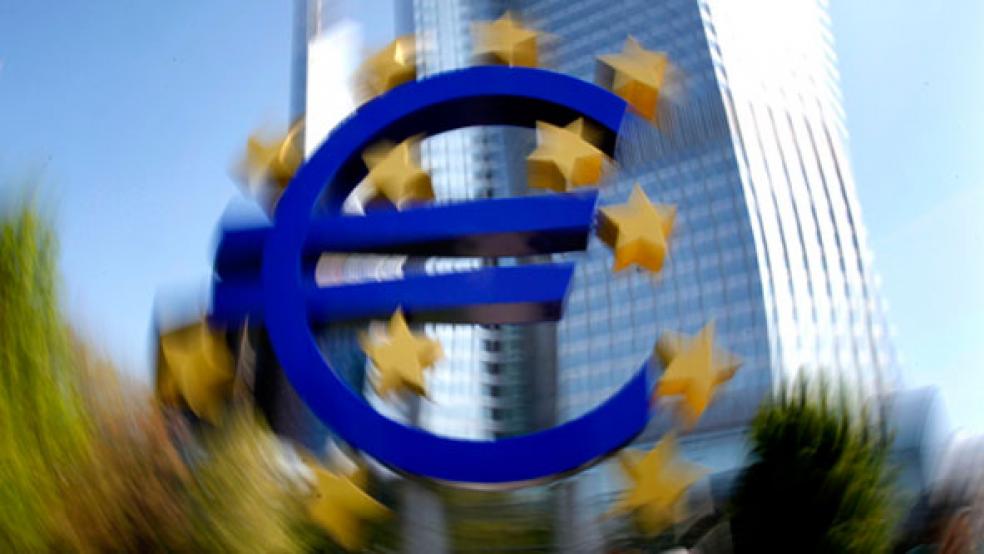Can you believe what is going on in the European debt markets? A few months ago the sky was falling and the euro itself was given no more than an even chance of surviving. Now investors cannot get enough of the sovereign bonds issued by Spain, Italy, Portugal, and others. The euro, to growing worry, is at a ten-month high against the dollar.

It makes no sense. So do not get too comfortable with the thought that Europe is in recovery mode. Better to brace for a serious correction. The Dow Jones industrial average is now at 13,650—not its record in 2007 (October 9, when it hit 14,164), but getting close.
On Monday the FTSE Index in London hit a record. This exuberant trading activity is highly vulnerable to the kind of reversal in the European debt markets that it is now perfectly sensible to anticipate. At the moment the action in the European markets is bubbly as Champagne.
Last Thursday Madrid sold $6 billion worth of bonds with mixed maturities at the best prices it has achieved in nearly a year. Spain’s benchmark 10-year bond is now priced at 5.03 percent; a year ago such an issue would have cost Spain more than 7 percent—the level at which financing sovereign debt becomes unaffordable and talk of bailouts begins.
The same thing is happening elsewhere. Portugal’s benchmark 10-year bond was priced at 17.4 percent a year ago; as of Monday it was 6.12 percent and falling. And let us not forget the Central and East European states, which were taking on a Greek-like pallor as recently as six months ago. Poland just sold $1.33 billion in six-year bonds http://eu.cbonds.com/news/item/626143 for a record low of 1.625 percent. Along with Hungary and the Czech Republic, it is front-loading its 2013 borrowing needs as quickly as it can—getting it cheaply, in other words, while the getting is good.
This market momentum was not achieved overnight. Some investors point to the famous “whatever it takes” speech by Mario Draghi, president of the European Central Bank, last July. That was when bond-buyers’ sentiment began to turn, they say, because Draghi revived faith in the EU’s capacity to resolve the crisis and preserve the common currency.
That could be. There are other advances to consider. Gross borrowing requirements as percentages of national output are coming gradually down. Ireland is expected to outgrow its bailout program and return to the bond markets by the end of this year; so is Portugal. Spain’s GDP contraction last year is likely to turn out to be less (if marginally) than the 1.5 percent forecasted.
So what is happening in Europe—and, more to the point, what is not? It looks as though Draghi and the ECB have fought the good fight for European unity and come out with an unanticipated result. For one thing, Draghi and his “whatever it takes” remark effectively created a market made of a perfect match.
The yields debtor nations are getting now on bond issues are stunningly low—unheard of for years. Among investors, liquidity is the driver now—they are awash—and those same yields look like the Klondike.
For another, there is the ECB’s Outright Monetary Transactions policy, decreed last August and put into effect a month later. The OMT is a dressed-up way of saying that the central bank in Frankfurt will purchase sovereign debt in the secondary markets. It is intended as a sort of mopping-up exercise; on the way to getting that done, it now appears to have artificially depressed yields on debt such as Spain’s.
This is how much you can rely on the debt markets to tell you what is going on in Europe: not much at all.
The missing part of the European picture these days, the thing not much mentioned, is the real economy. Financial markets are famous for their detachment from fundamentals, and this is what is on display in Europe now. What has to be answered is the question Europe has shied from the whole of the crisis: Will rigorous austerity measures alone do the job, or are demand-oriented growth policies going to prove essential?
The markets are hoping that austerity strategies will prove out this year. The mascots for this team are Ireland and Spain. Here is how Spain’s foreign minister, José Manuel García–Margallo, put it to investors recently. “The government is adopting the right measures to overcome the crisis, and these measures are about to bear fruit. Foreign investors are coming back.”
This is a risky strategy. García–Margallo is one of many political figures currently enraptured by the bond markets. In reality, the roof could begin to crumble on conservative Prime Minister Mario Rajoy as early as this week, when Madrid will release a raft of numbers looking back on 2012 and forward into this year.
Here is a better picture. Spain’s exports are falling, it was reported Monday, and GDP is expected to contract by 1.5 percent this year. The default rate on commercial loans is running at 17 percent. House prices last year likely declined for the fourth year running. And when the jobless numbers come out on Thursday; they are expected to have risen to a record 6 million (26 percent) in the final quarter of 2013.
You find variations on the Spanish theme all over Europe today: Real economies in the cellar, the markets celebrating upstairs, political leaders accepting market logic as logical, and a correction rolling at them like a big, black bowling ball.
These are our questions, and they will demand our attention like no other this year: Where does growth come from when the government sector, the private sector, and the export sector are all contracting? When can we declare victory over this economic crisis…if ever.






